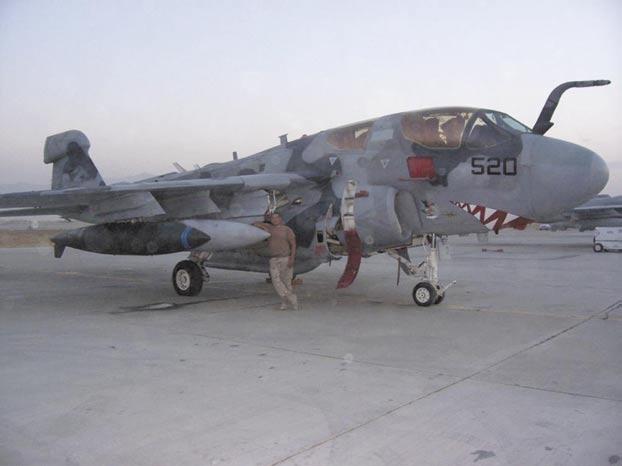
26 minute read
No Excuses for a Lax Attitude
By AD2 Mark Soto
We started the day just like any other aboard Bagram Air Base, Afghanistan, with a maintenance meeting, FOD walkdown and combat flight ops. We all know that deployment life is one filled with hard work and minimal play. We were only one month into our deployment, and already the vigorous schedule was starting to wear on us—complacency was beginning to set in. This story relays how a simple drop-tank removal, done carelessly, resulted in a mishap that easily could have caused serious injury.
Advertisement
About mid-morning, a member of the corrosion work center asked me, as power plants LPO, to download two 300-gallon drop-tanks from the “hangar queen.” Without much thought, and in an effort to help out my shipmates, I agreed. What I should have asked myself was, “Why is corrosion directly tasking the power plants shop to do maintenance?” This statement should have been my first clue that maintenance control knew nothing of the intended tank removal because no MAF had been issued for the job.
I asked my Sailors to go ahead and check out all the tools they would need for the job. I also should have made sure they were clear on what they were going to do. Of course, they left the shop without a drop-tank checklist. So one second class, one third class, and three airmen walked out of the shop…sounds like the start of a good bar joke. But there’s no joking around when it comes to the absence of common sense and ORM.
They proceeded to the jet to remove the droptanks, and the supervisor observing them asked if anyone had checked the tank for fuel. He proceeded to open the fuel cap to verify the tank was empty, and it was safe to release. The tank was dropped, and the supervisor walked over to corrosion work center to help them prepare paint for an upcoming job. During this
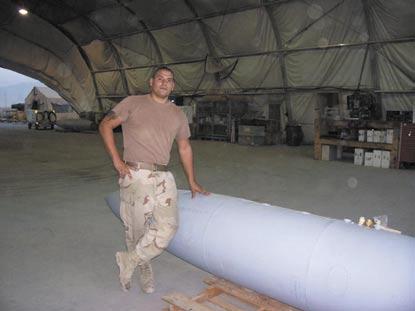
time, the rest of the drop-tank crew moved to the other drop-tank. Assuming it was empty, like the previous one, and believing it had been checked, they positioned themselves around the tank to grab it when released from the rack.
I was in the shop helping one of my CDIs sign off an oil-pressure gripe just completed on aircraft 523. Since the jet was getting ready to fly, it was my priority. I wasn’t able to supervise the tank download, but we had removed and replaced countless tanks in the recent past. My shop always had strived to do things by the book. I trusted they knew how to do the job and had complete confidence in their ability to do this simple task correctly. Unfortunately, I was mistaken. I was ready to sign off the oilpressure gripe when one of the airmen assigned to the job flew into the shop screaming, “We just released the other drop-tank, and it still was full of fuel.” We immediately ran to the clamshell and located all the Sailors involved, making sure they were all OK. In complete shock, I grimaced as I looked at the scene. On the deck sat a 300-gallon, 2,000-pound drop-tank that had been full of TS-1 fuel. It now was in front of me and gushing profusely from where it had split open. The base hazmat team was quick to respond, and the spill was contained with minimal impact; however, the incident easily could have injured or killed one of my Sailors as it fell to the deck from a height of more than 4 feet.
Fortunately, no one was hurt, but the shop and squadron learned a valuable lesson about what happens when complacency gets in the way of sound judgment and procedures. I learned you can’t take anything for granted and must do an ORM review before every task.
Petty Officer Soto works in the power plants shop at VAQ-141.
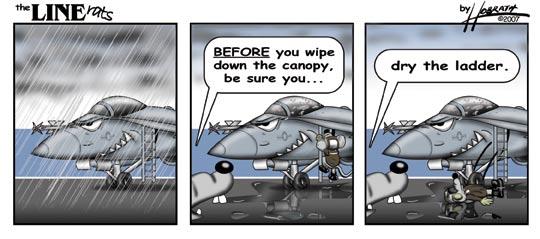
Send BZs to: SAFE-Mech@navy.mil




AEAN James Carriere VAW-115
Airman Carriere was the brake rider on an E-2C Hawkeye being respotted on board CV-63. While the aircraft was being towed across the deck, the tow bar and chain disconnected from the aircraft. This event created a severe hazard to personnel, aircraft and equipment as the 54,000-pound aircraft quickly could have gained momentum on the pitching deck. Airman Carriere immediately recognized the danger and brought the aircraft to a stop, applying brakes and dropping the hook.
AM3 Nino Michdeusen Bacani VAW-115
Petty Officer Bacani noticed hydraulic fluid leaking from the engine of an E-2C Hawkeye while the aircrew was doing the pre-start checks. He took immediate action and notified the plane captain and crew so he could troubleshoot the problem before the engine starts. When the engine panels were removed, a steadily increasing leak from the propeller pump housing was found. Had this problem not been noticed, the pump housing certainly would have failed in flight, resulting in an engine pitch-lock failure and endangering the crew.
AM3 Brian Whaley VAW-115
Petty Officer Whaley was the first responder to an airman who had been sprayed with caustic paint-stripping chemicals while doing corrosion control work on the flight deck. He took immediate action to remove his shipmate’s contaminated personal-protective equipment and chemically soaked clothing, and then flushed the areas exposed to the chemicals with water.
Recognizing the seriousness of the situation, he rushed the injured airman through a shower to rinse off any remaining hazardous material and escorted him to the ship’s emergency room. He then located the appropriate material safety-data sheet and delivered it to ship’s medical to ensure the injury was treated properly. His swift response was vital to minimizing the seriousness of the chemical burns and enabled his shipmate to return to work the following day.
AM1 Rochelle Wilks VAW-115

As the Hawkeye’s engines shutdown, the blades continued to spin at a lethal rate but without any audible warning to Sailors. Petty Officer Wilks recognized that a maintainer, unaware of the danger, was ducking under the rear stabilator of a Hornet to check the side of the aircraft adjacent to the Hawkeye. Knowing only three feet clearance existed between the spinning blade and the Hornet, she immediately prevented him from walking into the spinning propeller. to be cambered slightly. He relayed his concern to the troubleshooter’s LPO, who took a closer look and noticed that the gap where the axle meets the axle lever varied in width around the circumference of the axle. The aircraft was downed and sent to the hangar.
When the tire-and-wheel assembly and axle were removed for inspection, maintainers realized the axle was not lubricated and the axle lever was corroded severely. The grease fitting on the axle lever was jammed and would not allow grease into the affected area.
Petty Officer Dial’s keen attention to detail prevented a certain mishap and allowed the quick return of an important asset to support combat mission in OIF.
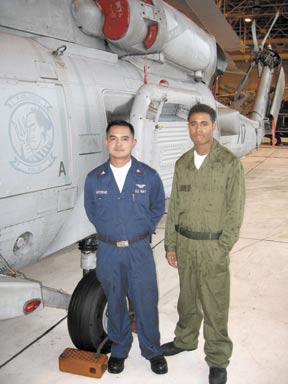
jet was moved, Airman Singh noticed that the right main-mount planing link was cracked and immediately downed the jet.
Airman Singh’s attention to detail prevented a definite in-flight emergency and possible mishap. Despite the rush to move the aircraft, his quick but thorough inspection allowed maintenance the time to get a spare ready for the next launch.
AM3(AW) Toby Dial VFA-136
Following a long and busy day of flight operations on board the USS Enterprise (CVN-65) and after a routine re-spot of Knighthawk 307, Petty Officer Dial noticed the port main landing gear tire-and-wheel assembly appeared
AMAN Jyoteendra Singh VFA-102
Airman Singh was assigned as the plane captain of aircraft 111 on board USS Kitty Hawk. After a night recovery, he immediately started a turnaround inspection because 111 was scheduled to go on the next launch. The deck crew told him they needed to move the jet. Doing a quick walkaround before the
AD1 Michael Natividad and AD3 Marlan Hoodwillis HSL-51 Det. 6
While troubleshooting a faulty fuel precheck valve on Warlord 717, Petty Officers Natividad and Hoodwillis discovered the pressure refuel hose inside the port fuel cell had failed. A portion of the deteriorated rubber lining of the hose became lodged in the refuel/ defuel valve, causing it to fail during refueling operations.
Petty Officer Natividad and Hoodwillis’ extensive troubleshooting, which was above and beyond normal efforts, correctly identified a serious discrepancy, allowing proper servicing of the fuel cell, preventing an overpressurization of the fuel cell, and avoiding structural damage of the aircraft.
AD2 Conrad Smith VR-53
Petty Officer Smith discovered two cracks in the aircraft bleed-air ducting during a daily inspection of a C-130T aircraft. While repairing the discrepancy, he determined that FOD had entered the bleed-air system. Additionally, Petty Officer Smith uncovered a broken mounting bracket which led to the discovery of two more faulty brackets in other squadron aircraft.
Petty Officer Smith’s thorough maintenance inspection technique eliminated possible fire and FOD hazards. environmental control system after a recent maintenance action, Petty Officer Green discovered an abnormally hot area on the underside of the aircraft. Calling for an immediate shut down of the engine, he noticed the paint and panel in the same area began to bubble and warp. Removing the panel, Petty Officer Green expertly traced the extensive series of ECS lines to the root of the problem: an improperly placed clamp hidden deep within the belly of the aircraft. His discovery of the bleed air leak prevented any further damage to the aircraft and the inevitable loss of aircraft and possibly the pilot.

the flight station who immediately shut down all aircraft engines.
A borescope inspection revealed signs of an impending turbine failure, including hot spots on the turbine and burner cans, a delaminated burner can, and cracked blades.
Had Petty Officer Kearns not noticed the sparks coming from the No. 2 engine during the final checks, the turbine may have failed in flight, possibly resulting in additional damage to the aircraft or loss of an aircraft and crew.
AME2 Nathan Green VFA-151
While doing a low-power turn on Vigilante 302 to leak check the
AM1 Daniel Kearns VR-53
On an early morning mission, 0430 brief for a 0630 takeoff, Petty Officer Kearns completed his preflight and engine starts as a C-130T loadmaster. He re-boarded the aircraft and during his post engine-start checks discovered sparks coming from the No. 2 engine tailpipe. Petty Officer Kearns notified
AM2 Shawn McNeal VR-46
While doing maintenance on C-9B 161530, Petty Officer McNeal found that a new landing-gear, unlock-assembly component was improperly configured. Had the component been installed, it would have prevented safe operation of the landing gear, causing the port main gear to wedge in the up position.
Petty officer McNeal’s knowledge, initiative and dedicated attention to duty prevented this serious condition from occurring.
AEAN Curtis Sanders VX-23
During a daily and turnaround inspection on an FA-18C before an afternoon flight, Airman Sanders discovered a sheared bolt on the swivel assembly for the starboard main landing gear. This bolt is a vital part of the assembly that attaches three separate landing gear actuator hydraulic lines to the upper side brace of the gear. Realizing the critical nature of this discrepancy, Sanders immediately advised maintenance control to down the airplane, while initiating a MAF for the airframes workcenter to correct the situation.
Had the discrepancy gone unnoticed, a complete hydraulic failure could have occurred to the landing gear system, resulting in a catastrophic hydraulic leak.

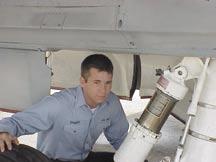
AO2(AW) Sean Nolan and AO2(AW/SW) Ginger Waters VFA-87

During a routine hot brake and de-arm evolution, aircraft 403’s starboard main tire ruptured because of overheated brakes. Petty Officers Nolan and Waters expeditiously signaled the pilot to stop the aircraft, secure the motors, and get out, while simultaneously securing the area and extinguishing the smoldering main mount with a Halon fire bottle.
The focused attention and quick actions of Petty Officers Nolan and Waters prevented significant damage to the aircraft and possible injury to the aircrew.

Petty Officers Rosasbarca and Harmon and Airman Daly discovered the port and starboard drag-beam bushing were worn beyond limits on Warlord 717. The excessive wear and tear on the bushings could have resulted in failure of the main landing gear and possible injury to the flight-deck crew onboard the USS Lassen (DDG-82).
Their thorough inspection and by-the-book work ethic quickly identified a serious problem. A depot-level repair team was brought in to assist in the repair while the ship was in port, ensuring minimal down time.
AM2 Juan Rosasbarca, AM2 Willie Harmon, and Airman Thomas Daly HSL-51 Det. 6
CROSSFEED
Maintenance Officer
Cdr. Bert Ortiz bert.ortiz@navy.mil
Editorial Coordinator
ADCS(AW) Michael Tate
Maintenance Management
IMRL 101
By ADCS(AW) Michael Tate
Many individual material-readiness-list (IMRL) managers or petty officers just seem to land in the job. Some have completed the course, but so much information is coming at them so fast it doesn’t stick. Other people come to work one day, and they’re handed the job. It’s easy to see how overwhelming this task can seem, and the program suffers until these people become familiar with it.
Fortunately, two instructions exist that will help the cause: COMNAVAIRFORINST 13650.3 and the NAMP, Volume V. You might have to blow the dust off both, but do it. I will share information with you to make your programs better.
What magic formula exists to beat this beast? Nothing but hard work and the references provided. Too often, people who are given a position of authority won’t ask for help or admit they don’t know an answer. We want to be viewed as a “go to” Sailor who always has the right answer. You have to get past this point. Asking for help doesn’t mean you don’t know your job. This new position is unfamiliar and not something learned in school.
IMRL is critical to our operational readiness. Only limited assets exist for each TMS aircraft, and they must be accounted for and taken care of. Seek out others who have figured out the program. Yes, you might have to hunt around a little. But the 13650.3 (enclosure 19) provides a list of people who can help—including the support-equipment controlling authority (SECA). Another person to ask, for most squadrons, likely is your wing IMRL manager. Most wings are proactive and actually are doing some of the daily management for you in the local asset management system (LAMS). michael.tate@navy.mil
A key issue is making sure your “main body” is not more than 18 months old. Possibly, it could be less than the 12-to-18 month timeframe if you’ve had a lot of activity, like transitioning to a new aircraft, series changes, or had a major change in SE requirements. If you need a copy of your main body, ask the SECA to provide it. When you get it, check the date because supplements may exist. For example, it’s November and the date on the main body is May. You should have supplements for June, July, August, September, and October. If they are missing, contact the SECA again.
Looking at the main body, you may notice numerous pencil marks (a best practice), providing it has been used or updated regularly. These marks will reflect the changes transferred from the supplements to the main body. This list is your master document and always should be up to date. If it does not contain these changes, then you should work the supplements into the main body—one month at a time and in order (June, July, August, etc).
IMRL gear is moved in and out of a command with transaction reports (T/Rs)—a checklist is available in the NAMP (Volume V, Chapter 19.2b(1) and (5), Figures 18-1 and 18-2). It should be used for all gear coming in or leaving a command (deletes in some cases are done as a best practice, when transferring the item, even if it is to DRMO). This step should be done for all gains and prime adds. The checklist should be routed in the order listed on the form, starting with QA and indicating the applicable manuals for the gear and what periodic maintenance shall be done. If this step is missed, then it indicates that your SE planned-maintenance
system needs to be repaired. The IMRL manager plays a key role in SE/PMS, too. For prime deletes, the checklist serves as a tool to make sure the work center (via QA) responds, stating they do or do not still need the item. If needed, the item can be transferred to the special tool side of the tool room. If not, then the PM record, along with the gear, can be pulled to await disposition.
When IMRL gear moves into or out of the work center and tool room, the LAMS report also must be updated to make sure you know where the gear is located. LAMS has two great management tools: barcodes and item pictures. No one can remember what every IMRL item looks like, and the slang terms that are used make it hard, too. A picture speaks a thousand words, so a best practice is to have photos of every item in the database.
Work-center IMRL petty officers and NCOs should be able to complete a quick quarterly inventory. They also should make sure the annual inventory is available in the shop, along with their quarterly inventory, which acts as their working copy. If an item has moved to a different shelf or box in the work center, the shop must tell the IMRL manager to make sure the appropriate change is made to LAMS, using the “location” and “local use” fields. To Go? By ATC(AW/SW) Danny Williams
According to the NAMP (Volume I, paragraph 14.8.2.c), QA is required to collect and provide maintenance and material data necessary to the safety officer for reporting via OPNAVINST 3750.5, when a report is required.
The safety officer is the expert on deciding when a hazrep should be submitted. If QA is not sending data to the safety officer when they submit an HMR, how does a squadron know they also may need to submit a hazrep?
The Naval Safety Center surveyed 72 commands around the fleet and asked the question, “Is the safety department informed when maintenance They need to make sure items are in working (RFI/ RFU) condition. If not, they need to be reported to the IMRL manager immediately, using one of the “F” codes found in the 13650.3, enclosure 16, paragraph 3. If an item is in “F” condition, the command must see if they can fix it, or they must start replacement procedures. If that item is source codes (SM&R) “M” or “A,” they shall be manufactured or assembled locally. Drawings can be obtained from NATEC (see the procedure in enclosure 9, paragraph 5). The command needs to take whatever action is necessary to fix or replace these items. The IMRL manager must track these items to make sure they aren’t sitting idle on a shelf.
While working the main body and LAMS, you’ll find a little redundancy, but that result is normal. Using the information I’ve provided will eliminate 90 percent of the problems the fleet faces. Remember to keep the main body up to date, using the supplements. Put the locations in LAMS, and never put the gear in service without routing the acceptance or transfer checklist. Do the basic steps shown, and you’ll be on the right path for IMRL and operational excellence.
Senior Chief Tate is a maintenance analyst at the
Quality Assurance
Do You Know Where HMRs Are Supposed
Naval Safety Center. submits an HMR?” Only 51 percent of the safety officers said they were being informed.
When an HMR is required, a hazrep often is needed, too. If we don’t pass along this information, then the Navy is losing valuable data. The information from a hazrep could keep other commands in a community from making the same mistakes. Analysis of this information can save lives and reduce mishaps.
We need to help each other to get out this critical information and to comply with the NAMP. It could make a world of difference.
Chief Williams is a maintenance analyst at the Naval Safety Center.
Avionics/Electrical
Joint-Services-Wiring Action Group (JSWAG) Addresses Fleet Issues
By CWO4 Ron Stebbins
The JSWAG and Joint Fiber-Optics Working Group (JFOWG) are collecting fleet wiring and fiber-optic issues and addressing them through program and logistics managers at the Naval Air Systems Command.
JSWAG has identified the leading causes of wire failures: exposed conductors, arcing damage, improper repairs, and chaffing. To enhance fleet readiness, the wiring manual was updated in a joint format. The Navy’s update is NAVAIR 01-1A-505- 1, and NATEC issued change No. 1 in November 2006.
Other updates: The Navy has developed computer-based training for wiring repair through a NAVAIR 6.7.5.2 fleet-training initiative. As the less reliable thermal circuit breakers are being phased out, the JSWAG is continuing the arc-fault circuitbreaker updates on C-9, H-53 and FA-18s. Aging wire studies are being done on P-3, H-1, and E6s, using reliability-centered-maintenance (RCM) analysis to minimize wiring failure costs. NAVAIR’s support-equipment team (PMA-260) has been busy developing a new automatic-wire test set By ATC(AW/SW) Danny Williams
Who’s in charge of batteries for the entire squadron? The answer is the avionics battery-program manager…of course. It’s amazing how many people in the fleet don’t know that fact. Who uses the batteries? Where are they stored? Where and how are they disposed of? These questions begin to show the scope of that person’s responsibilities.
How many different kinds of batteries exist? The most common ones, in no particular order, are lithium, ni-cad, lead-acid, nickel-metal hydride, and alkaline. It’s important to know this information because storage requirements are different for each one. (AWTS) for I-level maintenance, and a fiber-optic test set (FOST). These new or updated tools should enhance repairs and reduce failures at repair sites.
As more aircraft and systems are updated with the latest fiber-optic technology, the JFOWG recognizes cabling failures will begin to increase. They are preparing for this eventuality and are pursuing enhanced repair methods. To that end, they are doing thorough reviews of fiber-optic issues with the FA-18, F-35 and C-130s. For more information on wiring issues, contact the following personnel:
Jerome Collins
NAVAIR 4.4.5.3, JSWAG Co-Chair jerome.Collins@navy.mil (301)342-0812
AOC(AW) Rich Burry
NAVAIR 6.7.5.2, Fleet Training richard.burry@navy.mil (301)757-3108
Warrant Officer Stebbins is the avionics division
Batteries, Batteries and More Batteries
head at the Naval Safety Center.
Lithium batteries may not be stored in a manned space because they can vent toxic fumes. They also cannot be stored with other types of batteries. Lead-acid may be stored in a work center for no more than 24 hours. Unless in California, alkaline batteries have no real requirements for storage or disposal. Storage requirements for batteries, other than lithium, are found in NAVAIR 17-15BAD-1.
Lithium batteries are a mainstay in survival equipment because of their large power capacity and long life. However, they are volatile and have special instructions for handling, storage, use, and disposal. Those requirements can be found in NAVSEA S9310-AQ-SAF-010. If you haven’t seen
that pub, save yourself future headaches and find, read, and live it!
Few squadrons store batteries correctly, and even fewer commands have correct procedures in place to handle a battery spill. Every squadron is required to have a spill kit, and it must be set up in an accessible space that contains premixed neutralizers for lead-acid and ni-cad spills. By ASCS(AW) Phil LeCroy
Have you ever walked out to a job site to grease a piece of support equipment or an aircraft and discover the gun had the wrong type of grease, or the secondary warning label had fallen off again? What about the antique grease gun the tool room issued that doesn’t work for various reasons? Or the command with only two of them, one checked out to Smith and the other one to Jones who just drove over it on a tractor, ending its life? Being a hard charger can be frustrating at times.
These problems soon will be solved with an innovative new grease gun. And although we don’t endorse specific products or manufacturers at the Naval Safety Center, we do want to make the fleet aware of any new product with significant safety features or that will save money over time. We have found a new, clear grease gun that appears superior in every way to the metal ones found around the fleet.
These new grease guns were designed to fulfill the needs of the military. Clear Grease Guns, Inc. and Lincoln Industrial Corporation have developed this new product that is made of a high-strength, resilient polycarbonate, with aircraft aluminum end caps. They are produced with “memory” that snaps back to the original shape after being compressed.
The clear design is important because high-tech machines can be lubricated with the wrong grease, requiring costly tear down to flush bearings and joints. We already have too much work to do without adding
These problems are just a few that I’ve seen in my short time at the Naval Safety Center. I’ll continue to share my findings in future articles and offer solutions to help.
Chief Williams is a maintenance analyst at the
Tools
Clear Case for Clear Grease Guns
Naval Safety Center.
A three-ton truck can’t crush it.
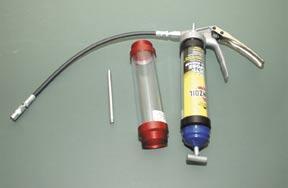
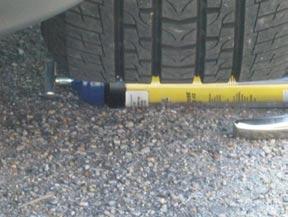
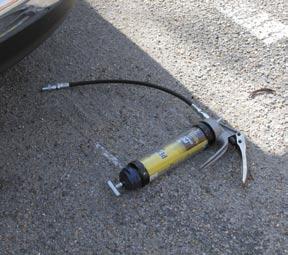
It survives with only a scratch.
unscheduled, self-inflicted work. The new product allows the user to see the type of grease being used, check the quantity remaining, and can be used with bulk grease or a cartridge. The gun also has a filler and bleed valve for clean filling or purging trapped air pockets. It also comes with a rigid tube and high-pressure flexible hose.
We tried to test the “memory” feature of the grease gun at the Naval Safety Center, but it defied all attempts to compress the polycarbonate. We struck it against a large metal object, put it in a vise, and parked a three-ton truck on top of it. These tests would have destroyed a metal gun, but we only could scuff it. The product is durable and should stand up to anything an overeager maintainer can dish out. This tool has been tested in the fleet, too. Here are some of the positive feedback reports that have been received on its ease of use and durability. By ADCS(AW) Michael Tate
From Dec. 15, 2006, to Feb. 14, 2007, the Navy and Marine Corps had 13 Class C mishaps involving 13 aircraft. These mishaps are all under investigation, so specific reports can’t be discussed.
A trend in this quarter’s mishaps could be identified: lack of attention while handling and moving aircraft and removing components. A common problem is not ensuring enough clearance exists when accomplishing these tasks. We end up with dinged, bent, dented, and smashed aircraft, equipment and people.
How many times have you walked past an aircraft and have seen someone removing a component without a lifting adapter, when you know one is required? In the past, that job might have been completed successfully using a shortcut—maybe even faster than with the right equipment. That success is a problem because a culture and norm gets established. All of a sudden, it’s OK to do it that way, even though it’s not “by the book.”
That method depends on luck, and someday that luck will run out. When it does, we have an injury, damaged equipment, or an aircraft loss.
“My opinion on the grease gun you showed me a few weeks ago is that it is a superior alternative to our current equipment. The quality is 10 fold what we currently use. In addition, the available options offered will increase productivity and safety,” said a maintainer from HMM(T)-164.
Another mechanic said, “I believe that this grease gun is the way of the future for Marine and naval aviation. I wish that we had had these when I was a young flight-line mechanic. Just the safety aspects of the grease gun far surpass any other.”
Others echoed this theme, “Recommend making this grease gun the new standard-issue equipment. Very impressed.”
The clear grease guns soon will be available in the supply system (under “Transparent grease gun”).
Senior Chief LeCroy is a maintenance analyst at
Class C Mishap Summary
the Naval Safety Center. When maintainers make those poor decisions, manuals get “written in blood.”
Aircraft moves are done correctly 80 percent of the time. Unfortunately, 20 percent of the time our people ignore infractions and don’t stop the move. We see people moving aircraft without whistles in mouth, wing walkers talking about any subject but the move, or people just staring at the deck, rather than being alert and taking care of the move. Towtractor drivers aren’t paying attention to the director, and directors accept it. Or worse, our senior petty officers walk past and don’t challenge these bad maintenance practices.
The fixes to these problems are simple and can be found in the core values of the Navy and Marine Corps: honor, courage and commitment. Leaders must lead, supervisors must supervise, and workers must do good, safe work. Honor implies you value the safety of people and equipment. You must have the courage to confront those people or situations who threaten safety. And you must have the commitment to do the best job possible, preventing bad maintenance practices from becoming the norm.
Senior Chief Tate is a maintenance analyst at the Naval Safety Center.
H otel Sierra Helping Sailors and Marines Help Themselves Sierra H otel
Commander, Naval Safety Center would like to thank the following aviation commands for their recent participation in safety surveys, culture workshops, and maintenance malpractice resource management (MRM) presentations for the months of January-March.

Safety

VFA-136 VAW-121 VP-30 HSC-48 AIMD Mayport VS-32 HS-11
Surveys

HS-15 VR-58 VFA-87 VAW-124 VFA-213 VMAQ-3 MALS-26 HMM-263 VMAT-203 VMA-542 VMR-1 VFA-211
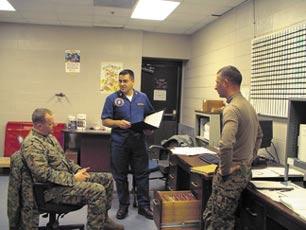
MRMs VFA-87 ASO VR-54 VR-53 VC-6 VAW-121 AIMD Norfolk VFA-211


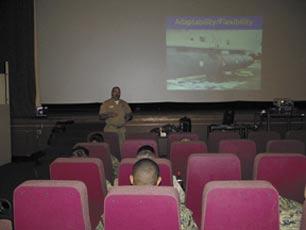
VR-58 VX-30 VAW-115
Culture Workshops
VMA-223 VMFA(AW)-224 AWSTS CMO HS-3 HSL-40 VAW-121 VFA-15 VFA-211 VP-30 VP-45 HSL-51 VAQ-133 VAW-116 VAW-117
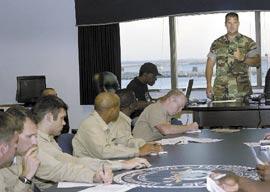
VFA-102 VFA-146 VFA-195 VFA-41 VQ-1 VR-53 FRC Norfolk
For more information or to get on the schedule, please contact: Safety Surveys: Capt Chris Foley, USMC at 757-444-3520 Ext. 7223, MRM: AEC Matthew Cooper at 757-444-3520 Ext. 7275, Culture Workshop: Cdr. John Morrison at 757-444-3520 Ext. 7213.






